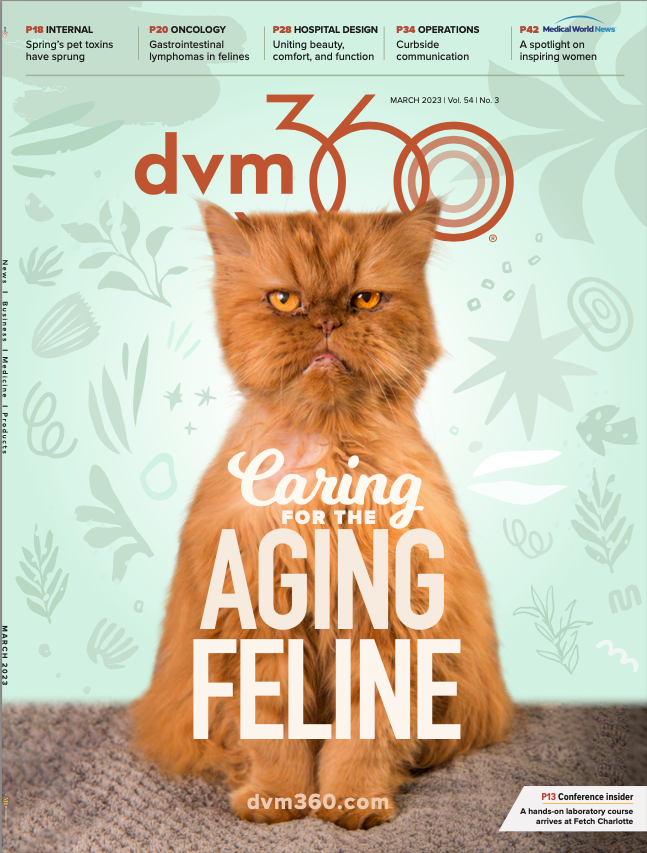Veterinary leadership requires women and minority individuals
Why it's important to have women in leadership positions
ssstocker / stock.adobe.com

The veterinary industry has made great strides in the past 100 years incorporating women into the profession, with women in the United States first graduating from veterinary colleges in 1903 and 1910.1 To see how far the industry has come in becoming more diverse and how much work is still needed to achieve true representation for women and racial and ethnic minority individuals, we need to look back at where this journey started.
Prior to the companion pet proliferation in animal care, most veterinarians worked with farm livestock—now commonly known as large animals—such as horses, cows, goats, and pigs.2 Farm animal medicine also encompassed poultry, stray dogs, and outdoor cats. With the advancement of transportation, animal care focused on dogs and cats as companion animals as they moved into backyards and inside homes. Today, large animal veterinarians still care for companion animals in a mixed animal veterinary practice.
The modernization of transportation has shifted the focus of veterinary care from the large farm to veterinary clinics. This transition led to benefits of less physical stress, minimal potential for bodily harm, and the ability to care for many small animals in 1 day. Although large animal medicine in the veterinary world is still widely practiced and needed, most large animal veterinarians work on industry farms for dairy, beef cattle, and sport horses.
Women and racial and ethnic minority individuals in veterinary medicine
Some veterinary colleges offer learning tracks geared toward companion animal and large animal care. Previously, veterinary students were trained in both large and small animal care. The student learned the anatomy of a cow and that of a dog, even though the student might never treat a cow postgraduation. Veterinary graduates are considered well-rounded medical clinicians for having this broad knowledge.
Like many professions, women were historically disenfranchised from pursuing veterinary medicine and its curricula. Because of the predominance of large animal care, women were often discouraged from attending veterinary school. The supposition was that women could not manage the scientific knowledge or the physicality of large animal care.
Animal health professionals from racial and ethnic minority groups have also faced harsh, discriminatory barriers of entry into veterinary medicine and widespread unequal treatment in accessing education. Several sources note that the first Black veterinarians, both men, were graduates of the University of Pennsylvania in Philadelphia in 1897 and Harvard Veterinary College in Cambridge, Massachusetts, in 1889.3,4 The first Black woman to graduate from a veterinary school was Alfreda Johnson Webb, DVM, a graduate of the first veterinary class of Tuskegee Institute (now University) in Alabama in 1949.5 Among all veterinarians in the United States in 2020, Black veterinarians composed less than 2% of the profession, whereas approximately 4.5% of veterinarians identified as Asian, less than 1% identified as Native American, and approximately 2.5% identified as another racial or ethnic minority group or identified with 2 or more groups. Conversely, 87.5% of veterinarians in the United States identified as White.6
Beginning in 2007, women began to outnumber men in the veterinary profession.4,6 In 2022, women composed 63% of the profession.7 However, even with this majority of women in the profession, very few are in positions of tangible leadership within the industry. This is even more pronounced for racial and ethnic minority individuals in leadership roles. Combining these statistics for women and racial and ethnic minority individuals, there is a demonstrated dearth of representation for racial and ethnic minority women.
The segment of the veterinary profession that shows the best female representation in leadership is the professional organizations segment, with women stepping into leadership roles in state veterinary medical associations (VMAs) and national VMAs. One example is the American Veterinary Medical Association (AVMA), in which woman have historically been active. In 1937, the AVMA had an officer position held by a woman for the first time, and the organization had its first 8 female president in 1996.8
Many animal care corporations are girded by nonveterinary leadership. A brief internet search of more than 30 veterinary industry companies shows the leadership level anecdotally supports the lack of women, racial and ethnic minority individuals, and veterinarians in key leadership roles. At best, this search will show a few women in executive-level roles and nearly nonexistent representation of racial and ethnic minority individuals. Looking at senior vice president and vice president roles, the representation of women increases, although there is still a blatant paucity of racial and ethnic minority individuals. The disparity between veterinarians and nonveterinarians in these roles is profound. We should question why veterinarians are not in critical management and leadership roles such as executive-level positions affecting
the profession.
Why leadership representation is important
Companies that embrace the veterinary professionals they wish to partner with in business will be most successful in quelling the problems plaguing the industry. Our industry is abuzz with leaders participating in roundtable enterprise risk assessments addressing the shortage of veterinary staff. Meanwhile, client and pet care needs increase, the competitive landscape evolves, an incursion of alternative options cannibalizes full-service veterinary care, and pressure on pharmaceutical revenue grows all while well-being and veterinary lives are at serious risk. Solutions range from more veterinary colleges and larger classes to new staff positions, telehealth, and online product sales.
However, these discussions and perspectives rarely consider how nonveterinary leadership has affected the profession. Additionally, they fail to address how the lack of inclusion of veterinarians, women, and racial and ethnic minority individuals in prominent decision-making positions creates homologous midlevel management and nondiverse executive-level leadership in a rapidly changing profession that is prominently female, with diver- sity, equity, inclusion, and belonging (DEIB) front and center.
The key takeaway is that veterinarians are best recruited, led, and coached by other veterinarians. Veterinarians understand their clients’ needs. Veterinarians and veterinary paraprofessionals respond to those who have walked the walk, held the paw, and comforted the pet parent. The veterinary corporation that demonstrates its emotional intelligence and business acumen by placing veterinarians, women, and racial and ethnic minority individuals at the helm of veterinary business will break the impasse. If there is something that veterinarians respect and gravitate toward, it is each other.
Leaders must walk the talk
Many veterinary companies that tout support of DEIB with statements and contributions to organizations fail to offer that support in house. This is demonstrated by the lack of women, racial and ethnic minority individuals, and other DEIB-inclusive representation in their leadership ranks. The challenge for veterinary corporations and their leadership teams is to take stock and turn the lens on themselves. If executive-level leadership is homogenous (typically male and nondiverse), there is a lack of self-awareness on that leadership team and the board of directors. If only nonveterinarians and White individuals in leadership positions present to teams that are more diverse, there is a blind spot representative of insensitivity at best and a callous disregard for the profession at worst. If women are not in key roles in higher-echelon leadership where the decisions are made and only men are speaking to hospitals that are led by women, what message is the business sending to women in the profession? Are none of the 63% of women in the veterinary profession intelligent enough to be executive leaders if they aspire to these roles? It appears that the companies that need them to care for pets would rather keep them in the treatment rooms. This is analogous to the recent past when women and racial and ethnic minority individuals were denied opportunities despite being well qualified.
Women and racial and ethnic minority individuals in executive leadership roles should not be alone in their positions within the veterinary industry. And yet they are. Leadership teams and boards of directors cannot satisfy this void with minimal representation of women and racial and ethnic minority individuals. It cannot be quelled with no veterinarians in executive-level leadership except in chief medical officer roles.
Female leaders and veterinarians not only deserve to be but are required to be in executive leadership roles in veterinary and animal care companies. Leaders and veterinarians from racial and ethnic minority groups deserve the same.
References
- Katić I. Pioneer female veterinarians. In: History of Veterinary Medicine. Hrčak; 2012:137-168. Accessed February 10, 2023. https://hrcak.srce.hr/file/125056
- Retrospective: a brief history of veterinary medicine. Oakland Veterinary Referral Services. September 27, 2019. Accessed February 10, 2023. https://www.ovrs.com/blog/history-of-veterinary-medicine/
- AVMA celebrates Black History Month by highlighting Black pioneers in veterinary medicine. News release. American Veterinary Medical Association. February 1, 2021. Accessed February 10, 2023. https://www.avma.org/news/press-releases/avma-celebrates-black-
history-month-highlighting-black-pioneers-veterinary#:~:text=August%20Nathaniel%20Lushington%20believed%20to,of%20the%20AVMA%20in%201920 - Diversity timeline. American Veterinary Medical Association. Updated July 22, 2020. Accessed February 10, 2023. https://www.avma.org/javma-news/2010-02-15/diversity-timeline
- Fields T. Black History Month-Dr Alfreda Johnson Webb. Alabama Gulf Coast Zoo. February 21, 2022. Accessed February 10, 2023. https://www.alabamagulfcoastzoo.com/black-history-month-dr-alfreda-johnson-webb
- Veterinarians. Data USA. Accessed February 10, 2023.
https://datausa.io/profile/soc/veterinarians - Veterinarian demographics and statistics in the US. Zippia. Accessed February 10, 2023. https://www.zippia.com/veterinarian-jobs/demographics/
- History of the AVMA. American Veterinary Medical Association. Accessed February 10, 2023. https://www.avma.org/about/history-avma
